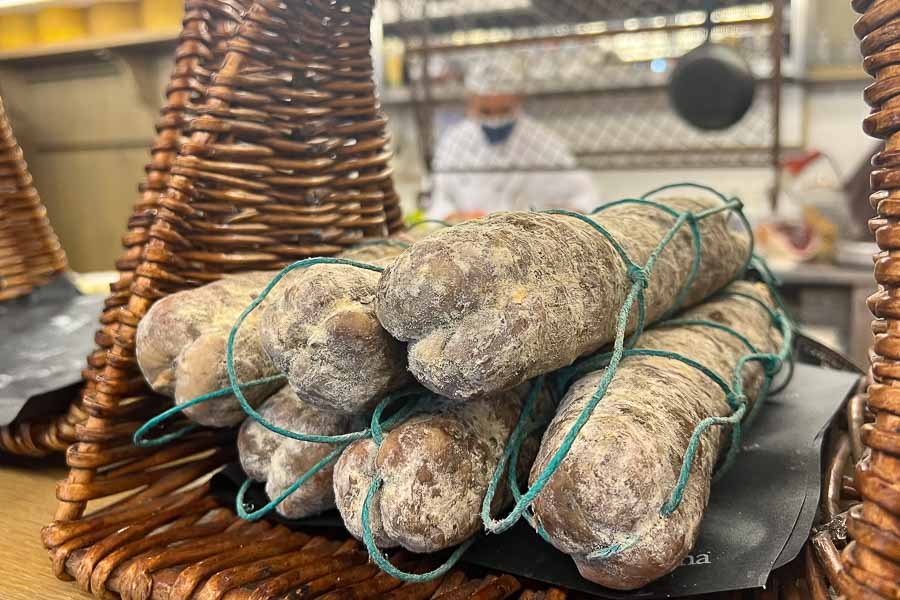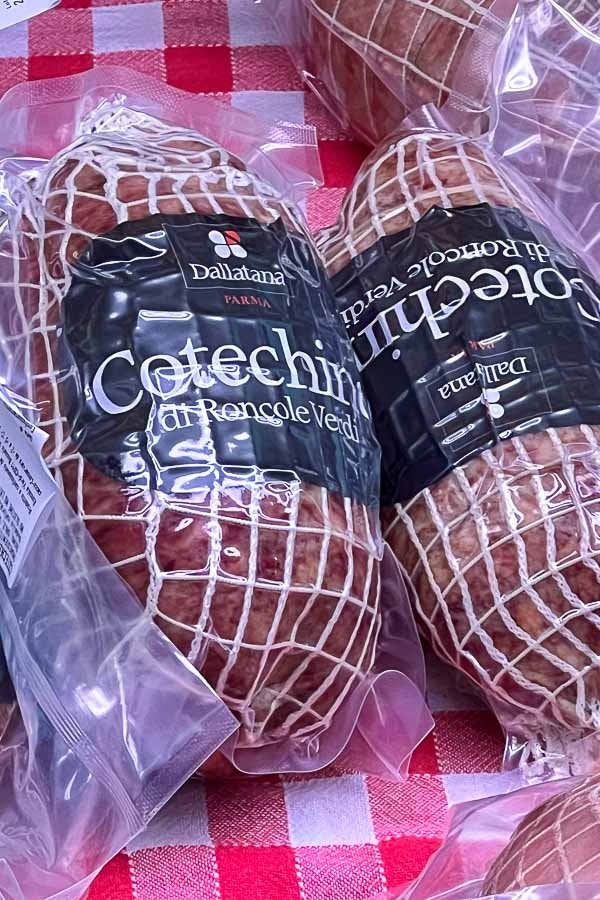A Tasty Tour of Culatello di Zibello, the “Little Ass” of Parma
There’s a lot for carnivores to love about Italian food, and here’s one more to add to your list — Culatello di Zibello!
Any foodie who has visited Emilia Romagna is familiar with one of the region’s most prized delicacies — prosciutto — a specialty Italian food product made in both Modena and Parma.
But have you heard of Culatello?
While many food travelers know prosciutto, not very many visitors have ever heard of or tasted Culatello di Zibello, sometimes referred to as Culatello di Parma — a ham that’s even more strictly crafted and dare we say, more delicious that prosciutto! Shhh, it’ll be our secret!
The very best prosciutto earns the DOP label, or Denominazione d'Origine Protetta, meaning Protected Designation of Origin), the important designation from the European Union Italian government that guarantees a food product is produced, processed, inspected, and packaged in a specific geographical zone according to a rigid set of rules and regulations.
Culatello is also one of Italy’s DOP products, but let’s just say it’s a cut above — or within — prosciutto!
Even after many food travels to Bologna and trying some Emilia Romagna’s famous foods like balsamic vinegar and parmigiano reggiano cheese, we had not heard of culatello.
But thanks to our friends at Emilia Storytellers, we visited a producer and sampled culatello on our latest visit, and now have a new delicacy to add to the list of why we love eating in Emilia Romagna!
What’s in this Article on Culatello di Zibello
What is Culatello di Zibello?
Making Culatello
Other Culatello Products
Culatello vs Prosciutto?
How to Tour and Where to Taste Culatello?
What is Culatello?
So what is culatello? It’s a smaller aged ham produced in a very small area around Parma. The area is so small in fact, there are just 23 producers in nine towns who produce the finished product. 23 producers… in 9 small towns!
One of these towns is Zibello, where the Culatello di Zibello product gets its name.
What’s the big deal about a small ham? All the meat used in a Culatello ham must come from pigs born, raised, and harvested in either the Lombardy or Emilia Romagna regions.
The cut of meat used to make culatello is the choicest section of a pig’s hind leg (think a high-quality ham in the US) and literally means “little ass.”
Unlike prosciutto the skin and leg bone are removed leaving just the main cut of meat — the culatello and the meat of the inner leg called the fiocchetto) for processing.
The texture is like thinly-sliced lardo, as if proscuitto took a slow crawl toward lox. It looks and acts like cured meat, but then collapses on your tongue.
Check out Italy’s Most Gluttonous Relay Race!
If you’re planning on visiting Parma in November, don’t miss November Porc, a month-long Italian food festival and relay race through the towns of Sissa, Polesine Parmense, Zibello, and Roccabianca that honors Parma’s famous hams.
Each weekend has a new theme and featured product to try and restaurants along the “Strada del Culatello” even offer local pork dishes at bargain prices!
Making Culatello
Philosophy
The overriding philosophy behind making culatello di Zibello can be summed up in 3 words: nothing is wasted. Producers take great pride in the fact that nothing from the butchered pig is wasted and every scrap is used to the benefit of the overall product.
Making Culatello In 5 Steps
The only ingredients used in the production of culatello ham are pork, salt, and pepper. The 10-11lb. (4.5-5kg) portions of meat are hung in humid cellars to age for a minimum of 15 months.
After the pork leg is cut to make the shape of a culatello, the first step is seasoning with some salt and black pepper. The mixture is massaged by hand over the meat to ensure that it’s spread evenly. To keep the product totally natural, salt is the only preservative used.
The salt causes the meat to weep out water. After one week of weeping the meat portions are weighed to determine the amount of salt to be used in the second step. There is less salt and pepper used in this step and the meat will continue to weep.
After this salting the culatello is hung in a windowless temperature and humidity controlled room for two weeks. This allows the salt to penetrate deeply into the meat.
The culatello are now wrapped with a natural cord to make them more compact, and pressed to rid the meat of air bubbles so that humidity or microorganisms can’t get inside and spoil the product.
Finally, the culatello are placed in a natural casing (actually, a pig’s bladder that has been thoroughly cleaned, much like the use of intestines as a casing for sausages in other countries including the US). The cleaned bladder is actually dehydrated for later use. To make it soft and allow it to stretch around the meat it is rehydrated with water and vinegar.
Once encased in the bladder, the culatello is bound by hand with a natural cord woven like a net around the meat with a loop at the top so it can be hung to cure. It was amazing to watch two people weave the net so quickly and evenly around the meat. We didn’t count how many they did while we were standing there, but it was a lot.
Aging Culatello
When all the previous steps are completed, the culatello are hung in a room at 43-45°F (6-7°C) to help get rid of any remaining excess moisture.
Interestingly, they are hung here with a plastic net around the meat to maintain its shape, and so it doesn’t become too dry as it shrinks.
Once this step is completed, the culatello are moved to a lower underground level. This is an important artisanal step in making culatello as it was done in the past.
The cellar has brick walls with air circulated throughout to maintain the proper temperature and humidity for aging.
Another important artisanal step is the opening and closing of windows on the lower level to maintain the proper temperature and humidity depending on the season.
This process in the cellar, especially the correct humidity causes a necessary mold to form on the surface of the culatello.
While in the lower level we couldn’t help smelling the ammonia in the air given off by the mold.
If all steps in the colder rooms are correctly followed, the culatello are moved to a room set at 68°F (20°C) for drying.
If a step was botched, there will not be an inspection. The DOP rules are quite strict.
Inspection
Prior to processing, the pig legs are inspected to ensure that the pig has been slaughtered at designated butcheries per DOP rules.
After a minimum of 10 months from the date of production the culatello are inspected by a certified official. The inspector uses a special small wooden mallet to tap on the culatello to hear if they sound solid or hollow, indicating an air pocket.
When the culatello are hung to age a red and white tag is placed on the hanging loop. If the culatello fails the inspection, the tag is removed and it can not be certified as DOP.
Once the culatello pass inspection, they are then aged a bit longer and can be sold after 16 months of aging. There are some that will be aged up to 3 years making them even more delicious.
Of note is that records must be kept showing all inspections. Failed culatello, if not spoiled, can be sold, but not as a DOP product.
Other Culatello Products
Strolghino
Made from the leftovers after butchering the the leg for culatello, this salami has the highest quantity in terms of production. It has a short curing process and is aged for only 10-12 days. It’s very popular to enjoy as an appetizer.
Fiocco
Made from the muscle on the inner thigh of the pig, it is smaller than a culatello. Trimmed to a round shape it is cured for 7-8 months in a cool cellar or a refrigerated room. It has a strong but sweet porky taste .
Spalla Cruda di Palasone
This is a typical salami and the oldest charcuterie product of the Parma region. The meat is cut from the shoulders of the pig then aged for 11 months in a cellar. The salami has a very strong but pleasant pork taste.
Salami Felino (IGP)
Also known as the "King of salami," Salame Felino (Protected Geographical Indication) is a soft sweet salami that is aged for 30-90 days in a cool cellar. It has the flavor of peppercorns and wine used when processing.
Culatello vs Prosciutto?
So what’s the difference between culatello vs prosciutto? And which tastes better? Let the debate begin!
One main difference between prosciutto and culatello are the climate of the two production areas, and the technique for curing and aging the meats.
These are two distinct products. Prosciutto is produced on a much larger scale, is cured with very little salt, and has a sweet taste. Culatello is more of a gourmet product produced on a limited scale when compared to prosciutto. It has what many consider to be a smooth creamier flavor that lasts longer in your mouth.
Which is best? We’re not taking sides on this one and have enjoyed both. Next time you’re in the Emilia Romagna region of Italy, it’s best to do your own taste test. You really can’t lose.
Where to Taste Culatello?
There are several ways to taste culatello on your visit to Parma:
Take a private tour of the culatello production facility in Parma like the one we took with Emilia Storytellers. While the facility itself is cool (quite literally, for obvious reasons), it’s a good way to gain a real appreciation for this specialty Italian food. After the tour, you’ll sit down to an amazing lunch featuring the aged culatello you just saw being produced, along with many other local Modenese food favorites and local foods like Parma’s Torta Fritta.
Or, book a small group tour with small group tour operators in the region. Get Your Guide has lots of top-rated tours to choose from:







